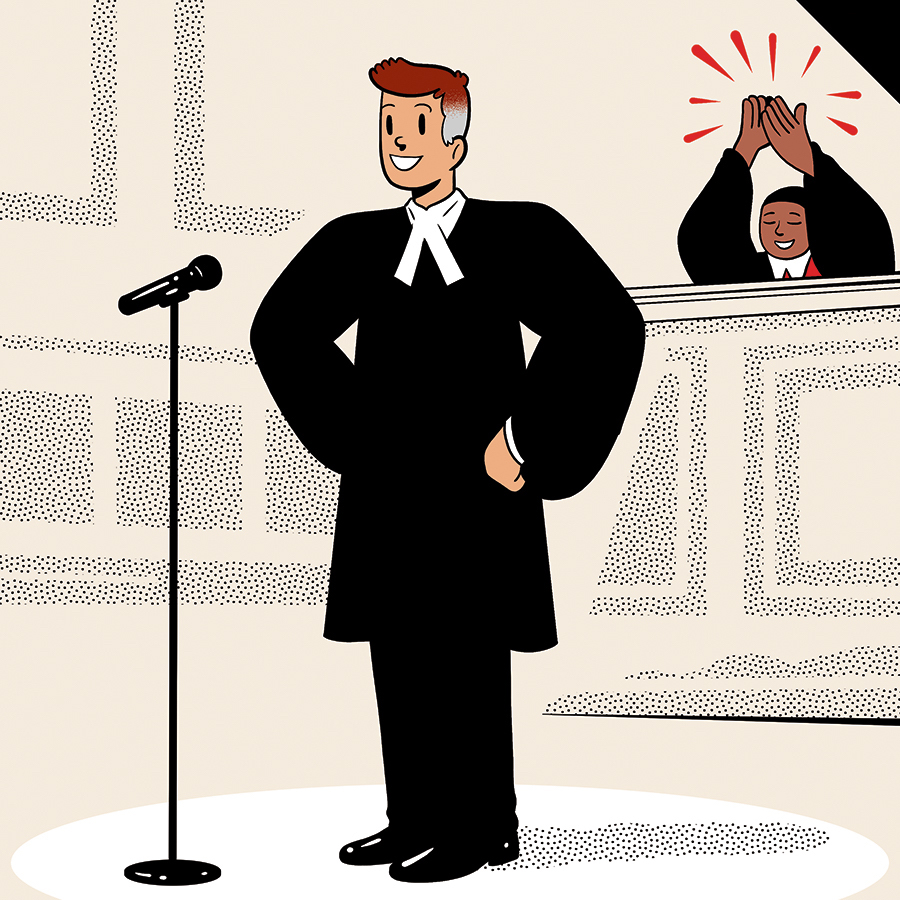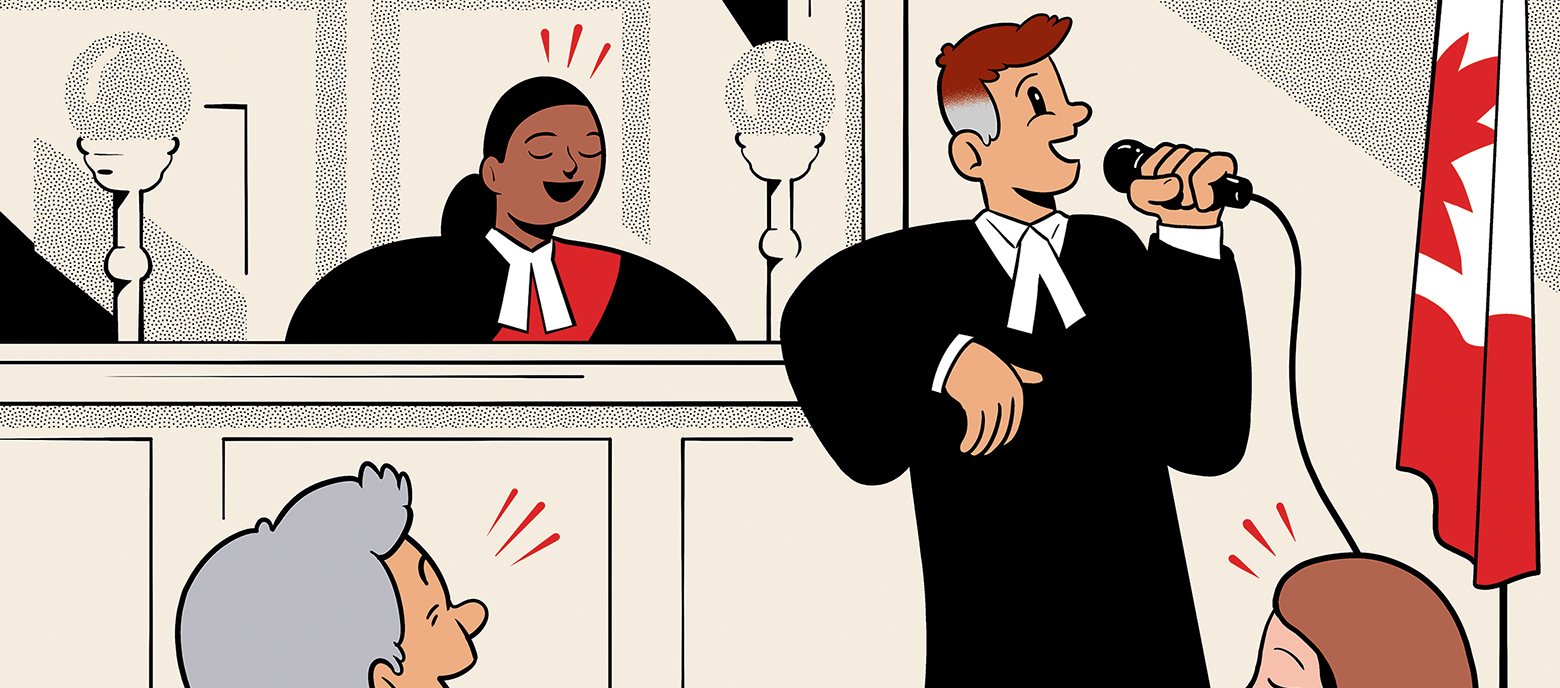Before law school, I was a professional stand-up comic. Looking over the last two decades of my career, I realize that many of the techniques I learned while writing and performing comedy made their way into my written and oral advocacy — perhaps by osmosis or simply as a matter of reflex. It’s not that I was slipping jokes into my legal submissions, mind you. As the old quote goes: dying is easy; comedy is hard. And comedy in court would lead to a cruel death indeed.
At root, the comedian and the litigator must overcome a similar set of obstacles. In the hopes of passing along a few nuggets of wisdom, I’ve identified five principles of stand-up comedy that also apply to litigation.
1. Relax and look like you belong there. Owning the space means projecting that you belong in it. When comics walk on stage, they have to take control immediately. Audiences, like any other natural-born predator, will pounce if they smell insecurity. You don’t have to be loud or aggressive. Steven Wright, the master of deadpan comedy, tells slow, methodical one-liners. Joke after joke, he never speeds up or looks like he is even trying. But the stage is always his.
It’s the same in court. This is your office, and you are at work. If you’re feeling nervous, uncomfortable with aspects of your argument or concerned about the angry client sitting at the back of the room, take a deep breath and remind yourself that, yes, all eyes are on you and should be on you. Like Wright, you can be measured and methodical and still project control. It doesn’t require bluster. And no matter how bored/angry/annoyed the judge may look, never, ever, act like you’re sorry that you are taking the court’s time. You are there to do the job you came there to do.
2. Address the elephant in the room. Pretty much every stand-up I know has read Judy Carter’s famous (if equally reviled) Stand-Up Comedy: The Book. It’s basically a paint-by-numbers guide for writing your first comedy set. One of Carter’s “gems” is to start by addressing your physical appearance right out of the gate. For comedy, I hate this advice. I could go on at length about how hackneyed it is to start out with a joke about your weight, ethnicity, hair, height and so on. To this day, I still see comics start out their sets with this low-hanging fruit. But if there is something that will truly distract the audience, it would be a mistake to ignore it. If someone breaks a glass, has a distracting laugh or heckles, you have to address it, lest you make the audience uncomfortable — or, worse, feel bad for you.
In the case of oral and written advocacy, addressing some obvious deficiency in your case is not just the opposite of hackneyed. It can be the difference between success and failure. Hitting it head-on and raising it early signals to the judge that you see this issue as well. It gives you credibility. If it’s obvious to you, trust me: it’s also obvious to the judge.

3. Tie it all together with a theme. Some stand-ups employ obvious themes. Jerry Seinfeld leans on his power of observation (“Did you ever notice how . . . ?”). Some use less obvious themes. Ricky Gervais’s jokes all seem to centre on how little of a crap he gives about anyone. Patton Oswalt takes every crowd down into a Dante’s Inferno of nerd culture. None of these comics announce their theme, but it runs through their material.
A strong theme will also help you communicate the legal theory of your case. How obvious or subtle you should be will depend on the case itself. But a legal argument without a theme running through it is — in my humble opinion — a ship without a rudder. For example, if the other side’s evidence is weak, weave that fact into your arguments. You might want to regularly refer to what’s missing, so that the lack of evidence is impossible to ignore. Above all, remember that it’s hard to move an irascible judge if you don’t have a point.
4. Brevity is the soul of wit. And legal writing. Joke construction is like poetry. The weighing of words must be done carefully. Too many words, or the wrong words, can kill a joke. As the old vaudeville comedy saying goes, “banana” is funny, but “orange” is not, even though they’re both fruits. So choose your words judiciously.
Like a tipsy audience at a comedy club, a judge will get annoyed if it is not clear where you are going. A one-hour stand-up act is usually broken up into “chunks” — meaning whole sections that have their own contained beginning, middle and end. As a general rule, I try to prepare my oral and written submissions in the same way. This allows me to jump around as needed. If the judge doesn’t need to hear anything about a certain issue or fact, I can leap ahead. If the judge is focused on a particular aspect of the case, I can be similarly nimble. Just like comics will move to a different “chunk” if they think that’s what the audience wants to hear.
The first part of an oral submission is the “set-up,” in which you need to make sure you are saying enough to allow the judge to follow along. Then you keep working toward the “punchline.” In legal submissions, the part that equates to the punch line of a joke is the conclusion you are asking the judge to come to. For instance, you might be building toward the following final sentence: “As you can see, my client is not liable.”
5. Sometimes it’s going to be a fight. The comic’s job is not to be the most liked person in the room. It’s to get the laugh. To move the audience with the joke. Many comics challenge the audience to laugh (or boo). Think of Larry David or (one of my personal favourites) the late, great Joan Rivers. Sometimes they want the collective groan.
In court, your job isn’t to befriend the judge; it’s to convince the judge. Sometimes, you have to take the court through certain evidence or law, even if the judge is fighting you every step of the way. One of the greatest learning moments of my career was watching a co-counsel take a judge through tens of pages of caselaw. All the while, the judge was barking, “Counsel, you can stop. You’re not going to convince me. I’ve made up my mind.” Yet the lawyer fought on. After two days of oral submissions and a long reserve, the decision came back. We won on every point, including the submissions that the judge said he wouldn’t be moved off of. Had the lawyer relented (to avoid further annoying the judge), we would have lost.
I could go on. There is a craft to stand-up that lends itself very well to oral and written advocacy. And like advocacy, there is a defined goal, an endpoint that signals success or failure. For the comic, it’s getting the laugh. For the advocate, it’s winning.
Peter Henein is a partner at Henein Hutchison Robitaille LLP. His practice focuses on commercial litigation, intellectual property and product liability disputes.
This story is from our Summer 2022 Issue.
Illustrations by Ryan Snook.


